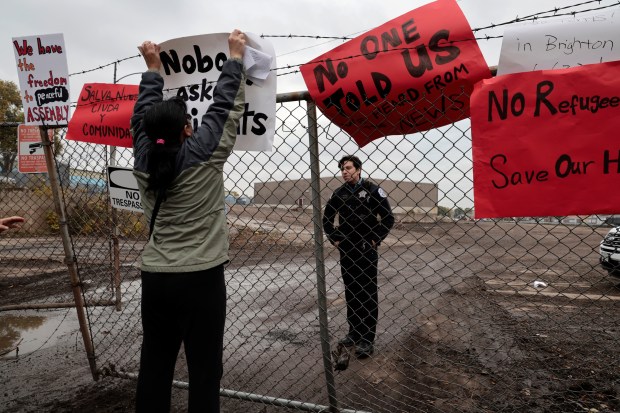If there weren’t enough polluted sites in Waukegan, the demolition of an ancient water tower in recent weeks caused additional contamination in one neighborhood. So much so that residents near the project have been promised remuneration by contractors.
The city must have the most federally designated Superfund sites, per capita, than any other location in Illinois. It seems it can’t ditch its pollution reputation.
There are five ongoing Superfund locations, with the coal ash pits at the former ComEd plant now owned by NRG Energy near the Lake Michigan shoreline a prime candidate — if officials are not careful — for eventually ending up on the roster in decades to come.
The U.S. Environmental Protection Agency lists three sites — Johns-Manville Corp., Outboard Marine Corp. and Yeoman Creek Landfill — on its National Priorities List. Two other sites, North Shore Gas North and South plants, are on the cleanup list under the EPA’s Superfund Alternative Sites program.
Most of us are familiar with leftover polychlorinated biphenyls used in hydraulic fluids from the manufacture of outboard motors on former OMC Corp. property north of Waukegan Harbor. Also, there are trichloroethenes, chlorinated solvents OMC used to degrease motor parts in the soil, according to the U.S. EPA. The site, too, hosted a coal gasification and coke plant facility in the early days of Waukegan’s industrial history.
Then there’s the 150-acre asbestos wasteland at the old Johns-Manville Corp. plant along the lake on the Far North Side. The 70-acre Yeoman Creek Landfill, which closed in 1969, on the city’s Northwest Side, is full of various manufacturing chemicals, including ammonia.
The two North Shore Gas sites, one 16 acres, are both on Pershing Road and also close to the lakefront. The EPA says the sites have been contaminated with residuals from old industrial facilities. Both have continuing groundwater monitoring.
So, with Waukegan’s post-industrial pollution legacy, you’d think overseers of the water tower demolition work would pay close attention to what was happening at the site. The 81-year-old water tower, unused for the last half-century, was off Keller Avenue, sitting behind the old Vista Medical Center West (aka the former St. Therese Hospital, which has had its own issues while being dismantled).
According to Steve Sadin’s front-page News-Sun story earlier this week, apparently, the contractors blamed weather conditions after the project began on Oct. 31 for spreading icy dust and debris from the demolition site and smothering city residents’ vehicles and homes. Ninth Ward Ald. Thomas Hayes said he saw the ice-dust combination blanketing vehicles in the neighborhood after sprayed water, a mitigation procedure used to keep dust controlled at the site, froze during cold weather, including snow and brisk winds, on Nov. 21.
It’s uncanny how the Waukegan demolition work is similar to what happened in the Little Village neighborhood on Chicago’s West Side four years ago when the botched demolition of a 380-foot smokestack at a former ComEd generating station saw dust covering the area. During and after the demolition, residents in the mainly Latino neighborhood some call the “Mexico of the Midwest” reported difficulty breathing along with continuing respiratory problems.
Contractors at the smokestack site imploded the structure with explosives while residents alleged a toxic plume engulfed their neighborhood. Environmental activists, calling it “environmental racism,” were outraged that Chicago officials failed to heed warnings and take proper regulatory action over contractors ahead of the demolition.
That oversight cost the companies involved in the demolition $12 million paid out to impacted residents, businesses and property owners, from a class-action lawsuit filed over the pollution. One after-incident report noted the dust from the work should have been known to be an unprevented byproduct of the demolition.
One Waukegan official said letters were sent to some 150 residents in the neighborhood close to the project notifying them of the work two weeks before the Halloween Day job started. Waukegan officials say they are in contact with contractors onsite to compensate residents for damage to their property.
Ald. Hayes, who walked the neighborhood and said he met with about eight homeowners following the dust incident, said he would give contractors a list of some of those affected.
It’s unsure if the dust from razing the Waukegan water tower is worthy of court action, but residents surely deserve to get something in return for the troubles they’ve encountered.
Charles Selle is a former News-Sun reporter, political editor and editor.
sellenews@gmail.com
X: @sellenews




